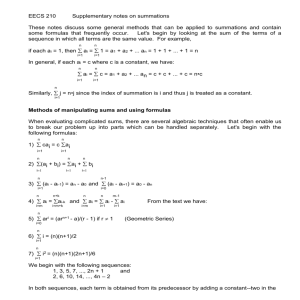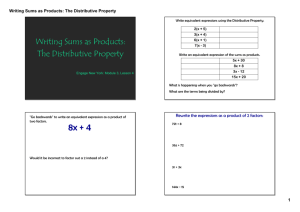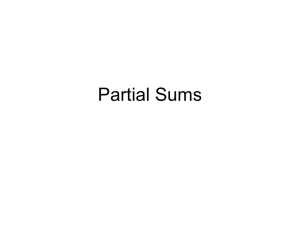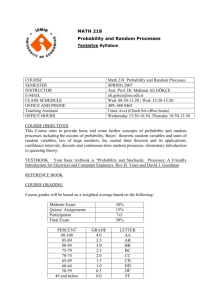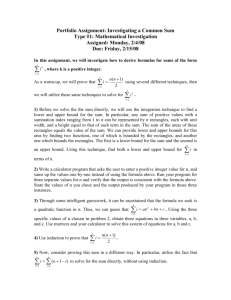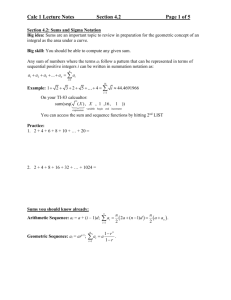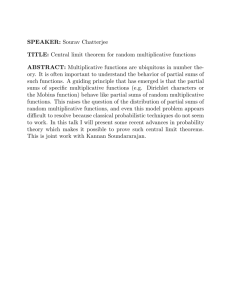Summation - Computer Science
advertisement
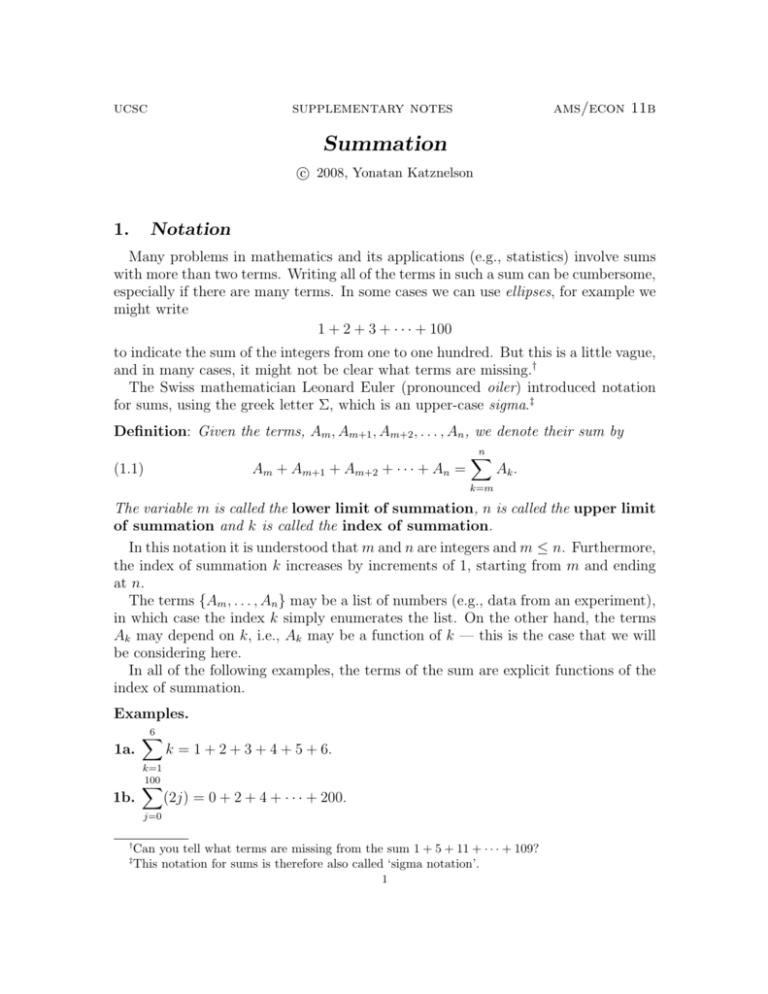
ucsc
supplementary notes
ams/econ 11b
Summation
c 2008, Yonatan Katznelson
1.
Notation
Many problems in mathematics and its applications (e.g., statistics) involve sums
with more than two terms. Writing all of the terms in such a sum can be cumbersome,
especially if there are many terms. In some cases we can use ellipses, for example we
might write
1 + 2 + 3 + · · · + 100
to indicate the sum of the integers from one to one hundred. But this is a little vague,
and in many cases, it might not be clear what terms are missing.†
The Swiss mathematician Leonard Euler (pronounced oiler) introduced notation
for sums, using the greek letter Σ, which is an upper-case sigma.‡
Definition: Given the terms, Am , Am+1 , Am+2 , . . . , An , we denote their sum by
(1.1)
Am + Am+1 + Am+2 + · · · + An =
n
X
Ak .
k=m
The variable m is called the lower limit of summation, n is called the upper limit
of summation and k is called the index of summation.
In this notation it is understood that m and n are integers and m ≤ n. Furthermore,
the index of summation k increases by increments of 1, starting from m and ending
at n.
The terms {Am , . . . , An } may be a list of numbers (e.g., data from an experiment),
in which case the index k simply enumerates the list. On the other hand, the terms
Ak may depend on k, i.e., Ak may be a function of k — this is the case that we will
be considering here.
In all of the following examples, the terms of the sum are explicit functions of the
index of summation.
Examples.
6
X
1a.
k = 1 + 2 + 3 + 4 + 5 + 6.
1b.
k=1
100
X
(2j) = 0 + 2 + 4 + · · · + 200.
j=0
†
Can you tell what terms are missing from the sum 1 + 5 + 11 + · · · + 109?
This notation for sums is therefore also called ‘sigma notation’.
‡
1
2
1c.
15
X
(i2 + i − 1) = 11 + 19 + 29 + · · · + 239.
i=3
Comments: As you can see in the examples, we can use letters other than k to
denote the index of summation. The letters i, j and k are common choices, as are m
and n (when they’re not being used to denote the limits of summation). Also, as you
can see in example 1b., the lower limit of summation may be zero (or negative).
Sigma notation is simply that — notation. It is not a tool for evaluating the sums
in question. To evaluate sums, we’ll use the basic properties of addition to develop
some simple rules and formulas. On the other hand, the Σ-notation will make these
rules and formulas easier to express and understand.
2.
Basic rules.
P
The only operation being used in the sum nk=m Ak is addition. It follows that
all the basic properties of addition hold for such sums. In particular, we can rearrange the terms in a sum, we can collect terms to split a sum into smaller sums and
multiplication by a constant factor distributes over a sum. The following three rules
illustrate these properties.
!
!
n
n
n
X
X
X
Ak +
Bk .
(Ak + Bk ) =
R1. Rearranging terms:
k=m
k=m
R2. Collecting terms:
n
X
Ak =
k=m
R3. Distributive property:
l
X
Ak +
k=m
n
X
cAk = c
k=m
n
X
k=l+1
n
X
k=m
Ak .
!
Ak
.
k=m
Examples.
6
3
6
X
X
X
k.
k+
k=
2a.
k=1
k=1
2b.
2c.
100
X
j=0
15
X
i=3
(2j) = 2
k=4
100
X
!
j .
j=0
2
(i + i − 1) =
15
X
i=3
2
i +
15
X
i=3
i+
15
X
(−1).
i=3
Comments: Rules 1. and 2. rely on the associative and commutative properties of
addition. Also, as you can see in the last sum on the right of Example 2c., the terms
in a sum may also be constant.
3
3.
Simple formulas.
One way of evaluating a sum is to simply add all of the terms together, one after
another, until we’re done. This is easy to do when the number of terms is small, e.g.,
6
X
k = 1+2+3+4+5+6 = 3+3+4+5+6 = 6+4+5+6 = 10+5+6 = 15+6 = 21,
k=1
and in many cases this may be the only option (for example in statistical applications).
On the other hand, there are many sums that can be evaluated using formulas. In
this section, I’ll introduce two simple formulas, and in the next two sections we’ll get
more sophisticated.
In all of these formulas I’ll consider sums from 1 to n,§ and the values of the sums
we consider will all be functions of the upper limit, n.
We begin with the formula for a sum of constant terms. This formula is selfexplanatory:
(3.1)
n
X
n
z
}|
{
c = c + c + c + · · · + c = n · c.
k=1
Next, we consider the sum of the first n integers: 1 + 2 + 3 + · · · + n. According
to mathematical legend, the famous mathematician Karl Friedrich Gauss discovered
this formula when
P he was about seven years old using the argument below.
Write Sn,1 = nk=1 k. To find a formula for Sn,1 , we compute the value of 2Sn,1 and
divide the result by 2. To compute 2Sn,1 , we add Sn,1 to itself in a clever way — we
write the terms in Sn,1 once in the usual (increasing) order, and below the first sum,
we write the same terms in reverse (decreasing) order, then we add the terms column
by column before adding the results of the columns:
Sn,1 =
1
+
2
+
3
+ ···
+Sn,1 = + n
+ n − 1 + n − 2 + ···
2Sn,1 =
(n + 1) + (n + 1) + (n + 1) + · · ·
+
n
+
1
+ (n + 1) = n(n + 1).
This gives the formula:
(3.2)
Sn,1 =
n
X
k=1
k=
n(n + 1)
.
2
Examples.
10
X
10 · 11
3a.
i=
= 55.
2
i=1
§
To apply these formulas to sums whose lower limit of summation is different from 1, we use rule
R2.. See example 3c.
4
3b.
20
X
(3j + 2) =
j=1
20
X
(3j) +
j=1
20
X
2=3
j=1
20
X
j + 20 · 2 = 3 ·
j=1
20 · 21
+ 40 = 670.
2
Note how I used properties R1. and R3., before applying formulas (3.1) and
(3.2).
!
85
85
85
9
X
X
k
1X
3610
1 X
1 85 · 86 9 · 10
3c.
=
−
=
.
k=
k−
k =
3
3 k=10
3 k=1
3
2
2
3
k=10
k=1
In this example, I first used property R2. to express the original sum from 10 to
85 as the difference of the sums from 1 to 85 and the sum from 1 to 9,
85
X
k=
k=1
9
X
k+
k=1
85
X
k =⇒
k=10
85
X
k=
85
X
k=10
k=1
k−
9
X
k,
k=1
and then I applied formula (3.2).
4.
Telescoping sums.
In certain important cases, most of the terms of a sum cancel each other out, leaving
only one or two terms. A sum like this is often called a telescoping sum, because it
collapses like a telescope. We can take advantage of this phenomenon to find more
formulas for sums.
Consider, for example, the sum
n
X
(2k + 1).
(4.1)
k=1
At first glance, there does not appear to be any cancelation, and indeed there isn’t.
On the other hand, by using a familiar identity from high school, we can express each
term in such a way, that that the resulting sum collapses down to two terms. The
identity I speak of is (k + 1)2 = k 2 + 2k + 1, which allows us to write
2k + 1 = (k + 1)2 − k 2 .
(4.2)
If we replace the terms in the sum in (4.1) by the right-hand side of (4.2), we obtain
n
X
(2k + 1) =
k=1
n
X
(k + 1)2 − k 2
k=1
2
= (2 − 12 ) + (32 − 22 ) + (42 − 32 ) + · · · + (n2 − (n − 1)2 ) + ((n + 1)2 − n2 )
= (n + 1)2 − 12 .
In other words, we have
(4.3)
n
X
(2k + 1) = n2 + 2n,
k=1
a formula that will guide us in the next section.
5
We can also use telescoping sums to find the sum of a geometric sequence. Recall
that a sequence of the form q, q 2 , q 3 , . . . , q n is called a geometric sequence. Our
goal is to find the value of the sum
2
n
q + q + ··· + q =
n
X
qk .
k=1
This sum is not telescoping, but we can transform it into a telescoping sum by
using the distributive property, R3., as follows. First we multiply the sum above by
(q − 1), and then distribute this factor to obtain a telescoping sum:
(q − 1)
n
X
k
q =
k=1
n
X
k
(q − 1)q =
k=1
n
X
q k+1 − q k = q n+1 − q.
k=1
Dividing both sides of this last equation by (q − 1) yields the formula
n
X
(4.4)
qk =
k=1
q n+1 − q
,
q−1
which is valid for any number q 6= 1.¶
Examples.
4a.
10 m
X
1
m=1
4b.
5
X
m=1
5.
2
3m =
=
1 11
− 21
2
1
−1
2
=
1
2
11
− 12
=1−
1 − 12
1 10
2
= 0.9990234375.
36 − 3
= 363.
3−1
Sums of squares and cubes.
In this section, I’ll use telescoping sums to find formulas for the sum of the first n
squares and the first n cubes, i.e., for the sums
Sn,2 =
n
X
k2
and
Sn,3 =
k=1
n
X
k3.
k=1
To get an idea of how this is going to work, I will first re-derive formula (3.2) in a
different way. To begin, recall formula (4.3),
n
X
(2k + 1) = n2 + 2n,
k=1
¶
How do we evaluate the sum on the left-hand side of (4.4) if q = 1?
6
which was derived using a telescoping sum. Next, we use rules R1. and R3. to
simplify the sum on the left, and express it terms of Sn,1 and n:
n
X
(5.1)
(2k + 1) = 2
k=1
n
X
k=1
k+
n
X
1 = 2Sn,1 + n.
k=1
Finally, comparing the right-hand side of (5.1) to the right-hand side of (4.3), we see
that
2Sn,1 + n = n2 + 2n
=⇒
2Sn,1 = n2 + n = n(n + 1),
and dividing by 2 yields (3.2).
list the steps we used in the second derivation of (3.2). To evaluate S1 =
PLet’s
n
k,
k=1
i. Use the algebraic identity
(k + 1)2 − k 2 = 2k + 1
P
to transform the sum nk=1 (2k + 1) into a telescoping sum.
ii. Use the telescoping sum to evaluate the original sum:
n
n
X
X
(2k + 1) =
(k + 1)2 − k 2 = (n + 1)2 − 1 = n2 + 2n.
k=1
k=1
P
iii. Use R1. and R2. to express the sum nk=1 (2k + 1) in terms of S1 and other
known quantities, and rearrange the terms to derive a formula for S1 .
To extend this idea to the sums Sn,2 and Sn,3 , we need identities analogous to (4.2)
for higher powers. These identities are
(k + 1)3 − k 3 = 3k 2 + 3k + 1
(5.2)
and
(k + 1)4 − k 4 = 4k 3 + 6k 2 + 4k + 1,
(5.3)
which you should check by simplifying the left-hand sides to verify that the right-hand
sides are correct.
Next, we observe that the identities above imply that
n
n
X
X
(5.4)
(3k 2 + 3k + 1) =
(k + 1)3 − k 3 = (n + 1)3 − 1 = n3 + 3n2 + 3n,
k=1
k=1
and
n
n
X
X
3
2
(5.5)
(4k +6k +4k+1) =
(k + 1)4 − k 4 = (n+1)4 −1 = n4 +4n3 +6n2 +4n.
k=1
k=1
These equations follow directly from the fact that the second sum in each equation
is a simple telescoping sum, (another fact that you should check!).
Finally, we use R1. and R3. to rearrange the sums on the left-hand sides of equations (5.4) and (5) to express them in terms of Sn,2 and Sn,3 (and other, known
7
quantities) respectively. We can’t do this step simultaneously, since we need to use
the formula for Sn,2 to compute the formula for Sn,3 , so we start with Sn,2 .k
It follows from the basic rules that
n
n
n
n
X
X
X
X
2
2
(3k + 3k + 1) = 3
k +3
k+
1 = 3Sn,2 + 3Sn,1 + n.
k=1
k=1
k=1
k=1
Comparing this to the right-hand side of (5.4), shows that 3Sn,2 + 3Sn,1 + n =
n3 + 3n2 + 3n, so
3Sn,2 = n3 + 3n2 + 3n − (3Sn,1 + n)
3n(n + 1)
= n3 + 3n2 + 2n −
2
2n3 + 3n2 + n
.
=
2
Dividing this equation by 3 gives the formula for Sn,2 :
n
X
2n3 + 3n2 + n
(5.6)
Sn,2 =
k2 =
.
6
k=1
The steps for evaluating Sn,3 are the same. We use the basic rules to show that
n
n
n
n
n
X
X
X
X
X
3
2
3
2
4k + 6k + 4k + 1 = 4
k +6
k +4
k+
1 = 4Sn,3 + 6Sn,2 + 4Sn,1 + n.
k=1
k=1
k=1
k=1
k=1
Then, we compare the right-hand side of this equation to the right-hand side of (5),
which shows that
4Sn,3 + 6Sn,2 + 4Sn,1 + n = n4 + 4n3 + 6n2 + 4n.
And finally, we solve this equation for Sn,3 , using the known formulas for Sn,2 and
Sn,1 :
4Sn,3 = n4 + 4n3 + 6n2 + 4n − (6Sn,2 + 4Sn,1 + n)
= n4 + 4n3 + 6n2 + 3n − (2n3 + 3n2 + n) − 2n(n + 1)
= n4 + 2n3 + n2 ,
and dividing by 4 gives the formula for Sn,3 :
n
X
n4 + 2n3 + n2
.
(5.7)
Sn,3 =
k3 =
4
k=1
k
Just as we needed the sum Sn,0 =
Sn,0 to evaluate Sn,2 .
Pn
k=1
k 0 = n to evaluate Sn,1 , and just as we need Sn,1 and
8
Comment: In principal, we can continue in this way to find formulas for any sum
of the form
n
X
Sn,m =
km.
k=1
Needless to say the formulas become more complicated as the power m increases. On
the other hand, all of these formulas do share one feature. Namely, for any positive
integer m, we have
n
X
nm+1
(5.8)
+ cm nm + cn−1 nm−1 + · · · + c1 n,
km =
m
+
1
k=1
where c1 , . . . , cm are constant coefficients. In some applications, it is important to
know the values of all the coefficients, but for the purposes of computing definite
1
, is important.
integrals, only the leading coefficient, cm+1 = m+1
Exercises.
1. Compute the sums:
10
X
a.
k 2 + 3k + 2 =
k=1
b.
8
X
j 3 − 4j 2 + 7 =
j=1
c.
20 m
X
2
m=1
3
=
2. Compute the sums:
15
X
2k 3 − k 2 + 3k − 1 =
a.
k=1
b.
25
X
3m =
m=2
3. Compute the following sums. Express your answers in terms of n and simplify the
expressions that you find.
n
X
a.
k 3 + 2k 2 + 3k + 4 =
k=1
b.
n m
X
2
m=1
3
=
n 2
1X k
4. Consider the sum
.
n k=1 n
a. Evaluate this sum. Express your answer in terms of n.
9
n
1X
b. Compute the limit: lim
n→∞ n
k=1
2
k
.
n
5. Verify that the identity (5.2) is correct.
6. Verify that the identity (5.3) is correct.
7. Show that (when q 6= 1)
(5.9)
n
X
k=1
kq k =
nq n+1 q n+1 − q
−
.
q−1
(q − 1)2
Hint: Multiply the sum by (q − 1) and collect like powers of q. The result is not
a telescoping sum, but it is fairly easy to evaluate using known formulas.
20
X
k
.
8. Use (5.9) to compute the sum
2k
k=1
n
X
k −k/n
e
. Express your answer in terms of n.
9. a. Compute the sum
2
n
k=1
k
Hint: e−k/n = e−1/n , now use (5.9).
b. Evaluate the sum in part
! a. for n = 10, n = 20 and n = 100. Do you think
n
X
k −k/n
e
exists? Can you compute it (or guess what it is)?
that lim
2
n→∞
n
k=1
